
© 2010-2025 by Fine Arts of the Southwest, Inc. All rights reserved.
Unauthorized reproduction or use is strictly prohibited by law.
An extremely rare and very beautiful Navajo Coin Ingot-Silver and “Hubbell Glass” bracelet, c.1900-1920
This is one of the most unique and interesting historic Navajo bracelets we have ever seen not to mention its exceptional rarity. It is unusual indeed to be able to know such specifics as the individual person, time frame, geographic place and materials used to place the creation of a century old piece of Navajo jewelry at a fairly precise place and point in history across the vastness of the great American Southwest, but it most definitely exists here.
The time frame of the bracelet’s creation is between 1900 and 1920, the place where it was made is the immediate area
of and around Ganado, Arizona in the far eastern part of the state some 40 miles from the New Mexico border and the
person responsible for the bracelet being what it is is the famed Arizona Indian Trader, Juan Lorenzo (J.L.) Hubbell (1853-1930). Hubbell was the Indian Trader’s Indian Trader; smart, dynamic, tasteful, hard-working and honest.
He endeavored to sell pieces of the highest quality always looking for ways to improve and he treated the Navajo silversmiths and weavers who worked for him and supplied his trading post with artworks fairly and with great concern
for their welfare as this quotation shows and they responded in kind giving him their best efforts and continued respect.
"The first duty of an Indian trader, in my belief, is to look after the material welfare of his neighbors; to advise them to produce that which their natural inclinations and talent best adapts them; to treat them honestly and insist upon getting
the same treatment from them . . . to find a market for their production of same, and advise them which commands the best price. This does not mean that the trader should forget that he is to see that he makes a fair profit for himself, for whatever would injure him would naturally injure those with whom he comes in contact."
-J.L. Hubbell

At left, Juan Lorenzo (J.L.) Hubbell, c. 1905-1910. At center, a modern-day view of The Hubbell Trading Post National Historic Site in Ganado, AZ. At right, J.L. Hubbell purchasing a Navajo rug from a Navajo weaver in front of the original Hubbell Trading Post, c. 1905-1910.
Left and right photo source and © National Park Service. Center photo source and © Wikipedia.
Above left, the bracelet shown alongside a natural Persian turquoise high-domed cabochon-cut stone for comparison. The Hubbell glass "stone"
set in this bracelet is J. L. Hubbell’s and his European glassmakers interpretation of the “Spiderweb” matrix appearance of this type of Persian turquoise. At right, two other Navajo bracelets of the same time period; the one at above right is set with a slightly different version of the “spiderweb” style Hubbell glass and the one at below right is set with clear blue Hubbell glass, an imitation of the ckear blue variety of Persian turquoise.
Above right photo source and © Shiprock Gallery, Santa Fe, NM
This bracelet is distinct evidence of this; the quality is exceptional, beautifully and traditionally crafted by an extremely talented unknown Navajo silversmith in Hubbell’s employ of coin ingot-silver in the time honored and painstakingly difficult traditional method of first melting down a quantity of American and/or Mexican silver coins and then casting the red-hot molten metal into a rough ingot-silver “slug”. This “slug” would then subsequently be heated and reheated annealed and annealed and hammered and hammered until it became the silver shank of the bracelet at which point it was time to decorate the bracelet's newly formed silver shank with its final details, set the central stone and have a finished piece.
And here is precisely where the historic reference points of time, place and person we mentioned earlier come together into
a much sharper focus. At first glance, this large oval-shaped high-domed stone appears to be a type of spiderweb turquoise known as "Persian", a beautiful bright sky-blue with a blackish-grey background matrix. However, upon closer examination, the “stone” is revealed to not only not be turquoise, but to not be a stone at all. What this material actually is, in fact, is a large and attractive piece of the extremely rare and elusive “Hubbell Glass”, an exotic and unique material which bears some degree of explanation. In the early 1900’s, few American turquoise mines were in operation and demand was rising for quality turquoise to use in the making of Native American jewelry due to the increasing impact and burgeoning of large-scale Southwestern tourism being created and promoted by The Santa Fe Railway, The Fred Harvey Company and, also, in part by enterprising Indian Traders such as J.L. Hubbell.
To meet this growing demand for quality turquoise, there was high-quality Persian turquoise itself available in Europe which was difficult to obtain and fairly cost prohibitive. In a stroke of financially prudent and artistic genius, Hubbell came upon the idea of commissioning the historic highly-skilled artisan glass makers in Czechoslovkia to make various imitation types of “turquoise” from art glass, a material they had been using for centuries to create all varieties of artistic and decorative objects. This was a brilliant idea, the material was very attractive and could be consistently manufactured and reliably supplied at a very reasonable cost. As seen above, there were several different varieties and versions of Hubbell Glass “turquoise” made for him, the spiderweb as in this bracelet, and the clear blue Persian the original of which had been the world standard of turquoise for centuries.
Hubbell gave these glass stones or beads to his finest Navajo silversmiths to use in making high-quality jewelry for him and they responded beautifully, as in this bracelet. Since the imported European glass idea worked so well for Hubbell, other enterprising Indian traders soon followed suit to some extent, but none as successfully as Hubbell. By 1930, with Hubbell’s death and with the discovery and production of more American turquoise this experiment was essentially finished, a brief but successful and significant period in the history of Native American jewelry and trading in the Southwest.
Back to some important details about this unique bracelet. The overall design featuring the eye-grabbing large high-domed Hubbell glass “stone” in the center set in its lovely, low very gracefully serrated silver bezel and the dramatically flaring outwards sides of the silver shank on both sides of the stone is dramatic and visually arresting and just as much so in terms of visual arrest are the alternating opposing panels of deep parallel chisel worked lines and plain silver which is quite simply a masterstroke of genius original design, strikingly Modernist in its spareness and spatial and textural impact.
The bracelet measures 5/8" in width at its center and point widens out to 1 1/8" in width at its widest points before tapering back down to 3/8” in width at its terminal ends. The inner circumference end- to-end is 5 1/2" and the gap between the terminals is 15/16" for a total interior circumference of 6 7/16", just under 6 1/2". The bracelet weighs a very comfortable 63 grams or 2 1/4 ounces. The bracelet is in excellent-plus original condition overall especially for its 100-plus years of age and has some very nice age-appropriate wear and the silver has a particularly excellent old aged patina and soft “feel” in the hand.
To say that any particular one piece of art is the “best” of something is always a difficult thing to categorize as there are so many different and variable considerations involved, but in terms of the exceptional quality of its artistry and craftsmanship, rarity, overall aesthetic presentation, true typicity and distinct historical and cultural significance, suffice it to say that this bracelet is, in our opinions, one of the very best historic Navajo bracelets that we have personally ever seen and that is saying something considerable indeed. It's a true collector’s piece, deserving of a proud place in any collection, private or public, anywhere in the world.
Price $4,850
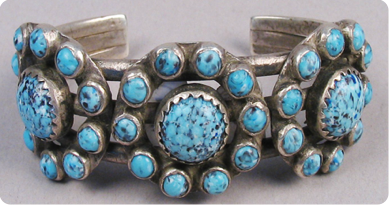
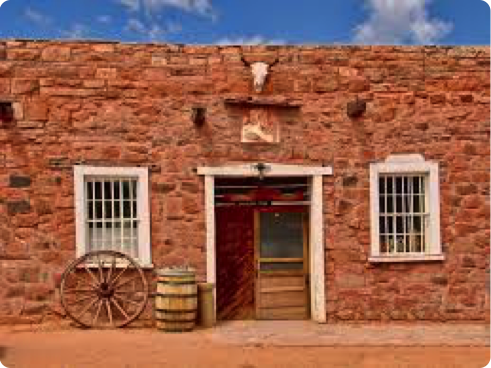
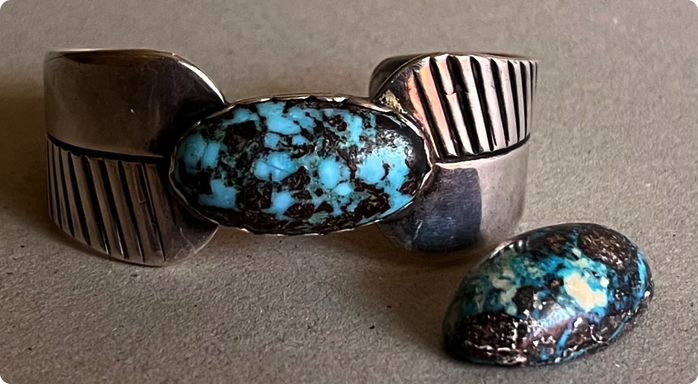
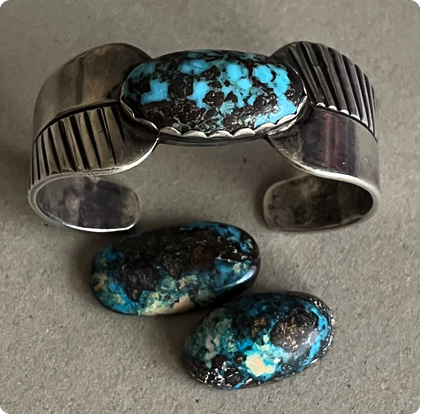
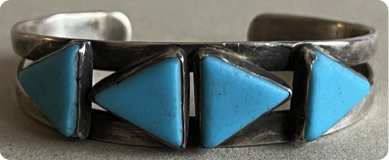
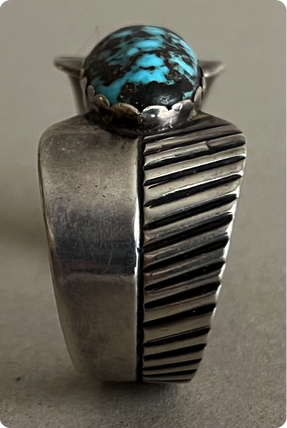



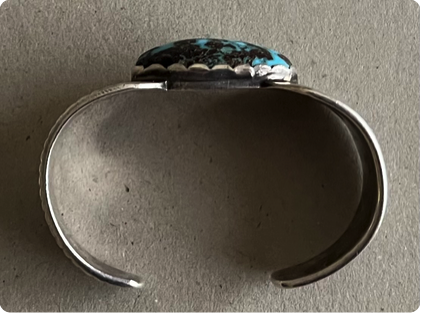
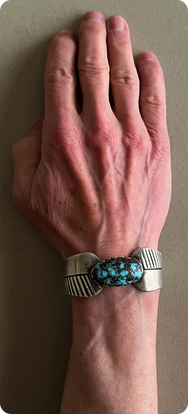
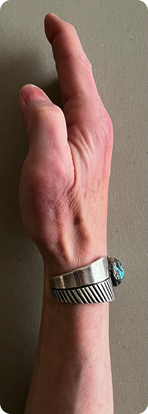

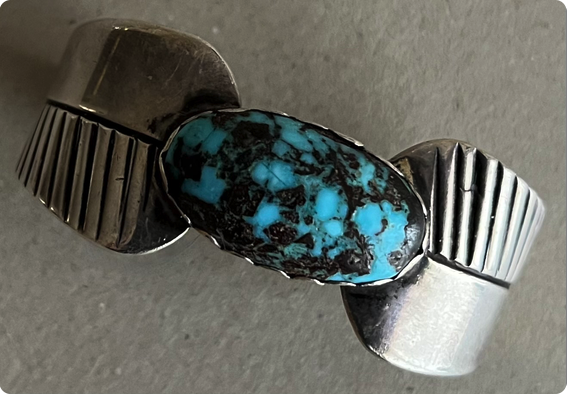
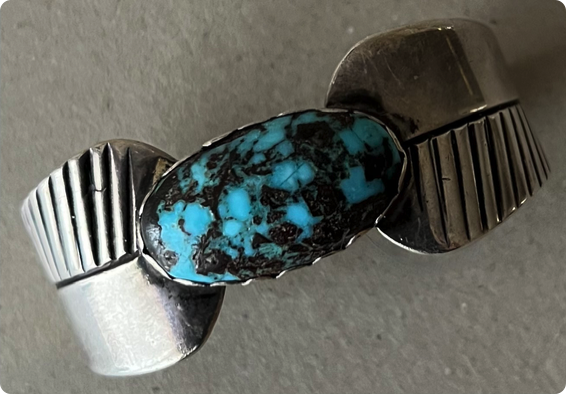
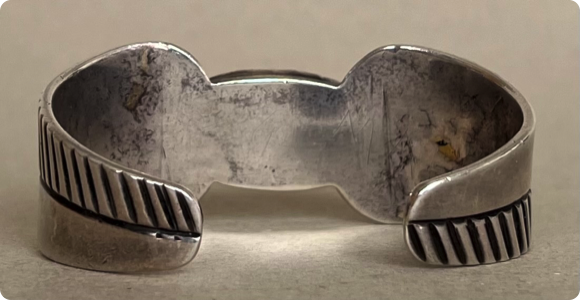
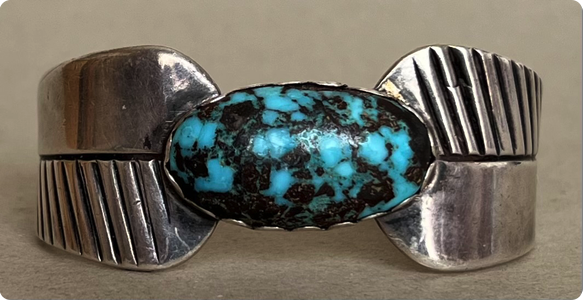
"Since the arrival of Europeans to the Americas, glass beads have been widely traded and incoporated into Native art. For many hundreds of years, Venice was the center of European glass productio, and Italian glass found its way to the most remote corners of the world. Beginning in the 19th Century, Czech glass makers took predominance, and small cottage factories produced huge amounts of glass for export.
While the Southwest has always been associated with turquoise, it was not always as plentiful or as available as it is today. In the early 20th century, Juan Lorenzo Hubbell imported a charcteristic light blue opaque Czech glass, in beads as well as larger chunks. Still known as "Hubbell glass", today it is a collectible in its own right."
-Quotation source and © Shiprock Gallery, Santa Fe, NM